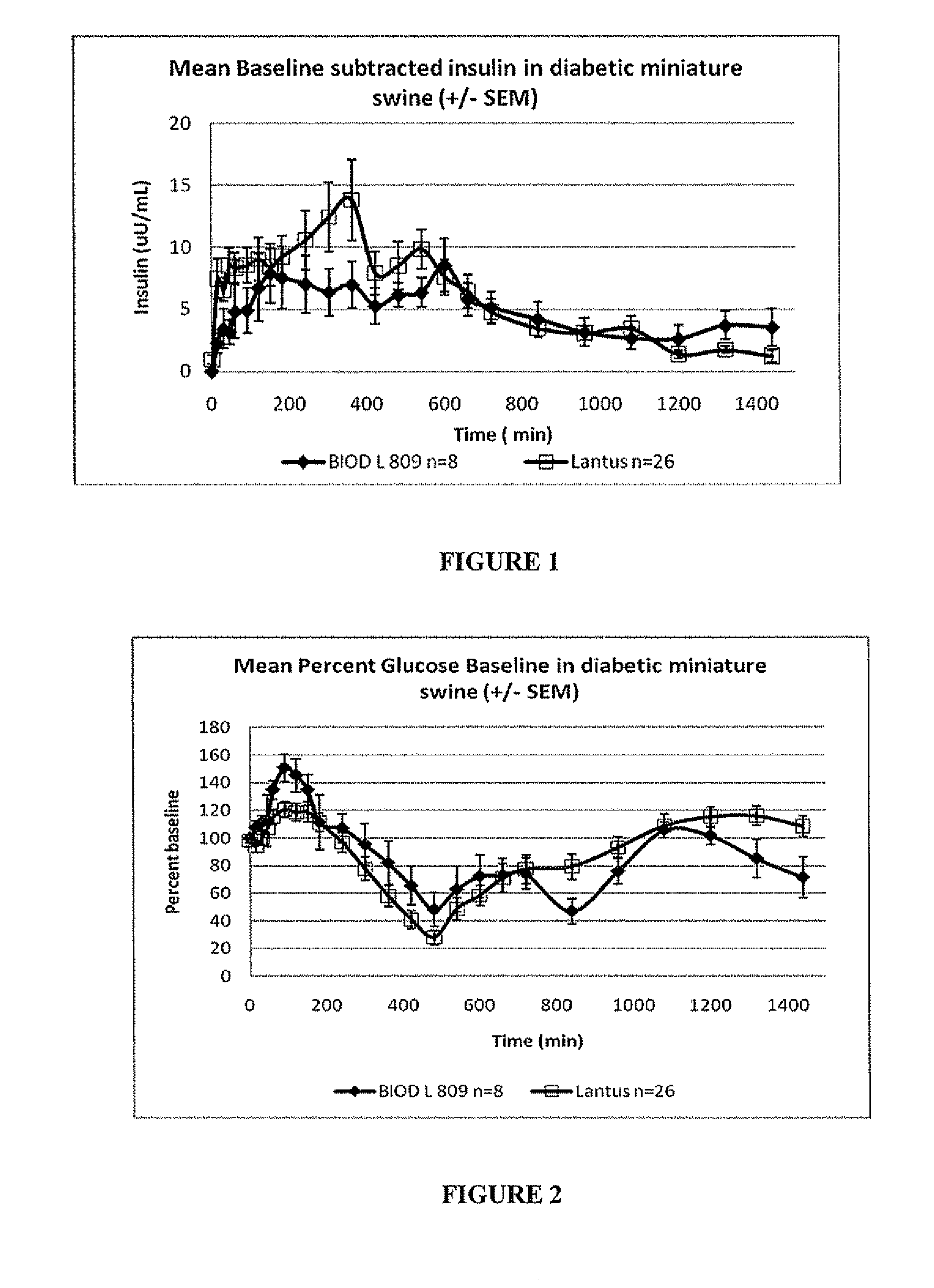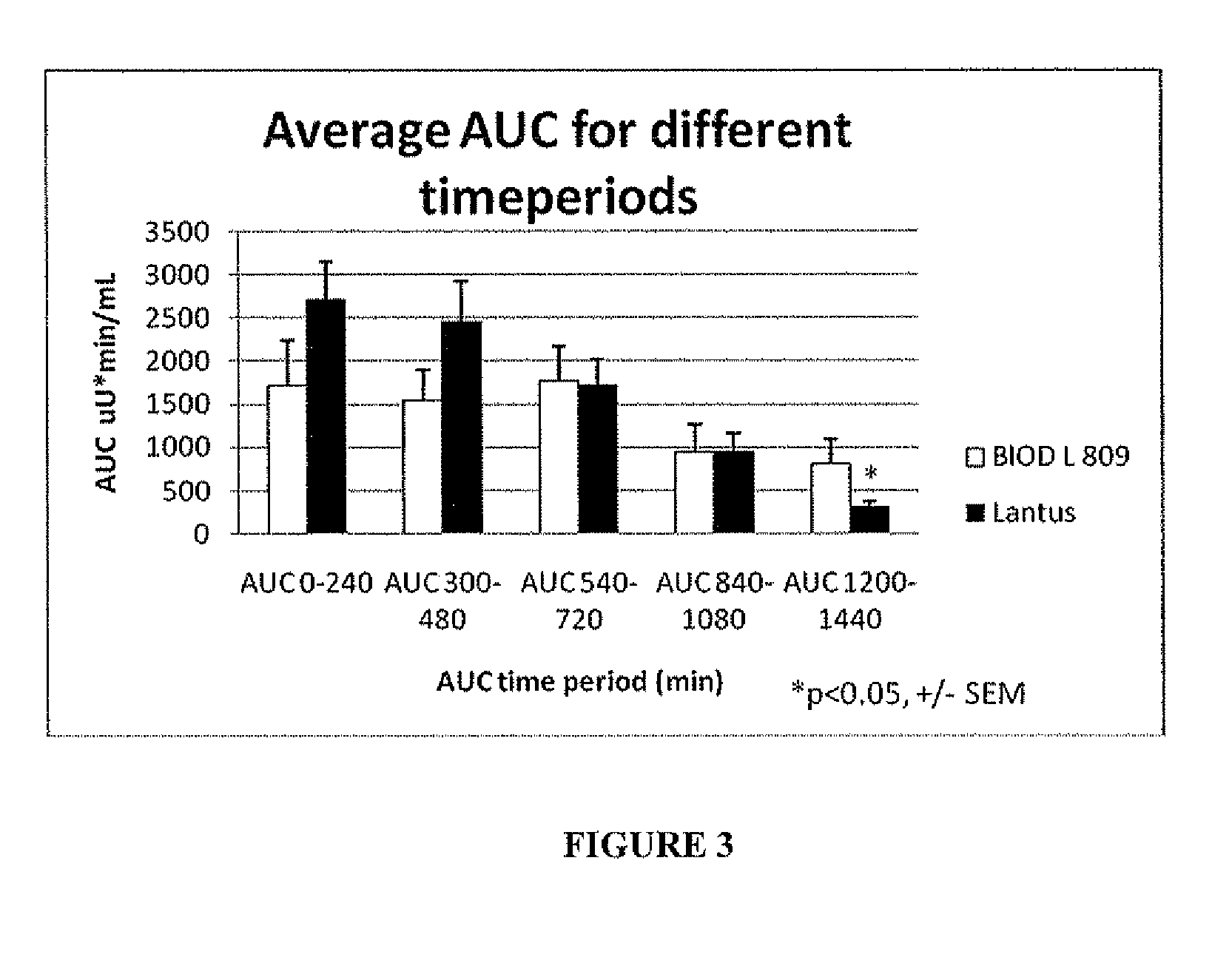Insulin with a stable basal release profile
a basal release and stable technology, applied in the field of insulin forms, can solve the problems of abnormally high blood glucose levels and inadequate levels of insulin, and affecting the ability of proteins, so as to enhance the precipitation of insulin particles, enhance the release effect, and improve the effect of soluble conten
- Summary
- Abstract
- Description
- Claims
- Application Information
AI Technical Summary
Benefits of technology
Problems solved by technology
Method used
Image
Examples
example 1
Excipients to Increase Duration of Release of Basal Insulin
[0059]Studies were conducted to determine which insulin glargine formulations would last longer post injection, with a “peakless” release profile.
[0060]Materials and Methods
[0061]Test formulations using commercial Lantus® were made by adding excipients to 1 mL of a clear pH 4 Lantus® solution. Excipients were: zinc chloride, phenylalanine, ferrous sulfate, iron dextran, and ferrous gluconate. The relative amounts are shown in Table 1.
[0062]The pH of the solution was then adjusted to 7 using a small quantity of 1N NaOH, which artificially induced the microprecipitate normally found post injection when the insulin is exposed to physiological pH. This precipitate was then diluted 240 fold in phosphate buffered saline solution and stirred for one minute at 37° C. The suspension (diluent and precipitate) was transferred into a centrifuge tube and spun for 6 minutes at 6000 rpm to pellet the suspended material. Supernatants were a...
example 2
Lantus® with ZnCl2 and Iron Dextran in Diabetic Miniature Swine
[0066]Based on the results in Example 1, the insulin glargine formulation combining 2 mg zinc chloride / mL and 1 mg iron dextran / mL was administered to diabetic miniature swine.
[0067]Materials and Methods
[0068]BIOD L 809 is a blend of 2 mg / mL zinc chloride with 1 mg / mL iron dextran, added to Lantus®. The swine were fed the day prior to the study and given their typical porcine insulin injection. Baseline glucose levels were taken the morning of the study. At time=0 the pigs were given a shot of BIOD L809 (0.45 U / kg) and fed their morning meal. A second meal was given at 480 min. and plasma samples were taken over a 24 hour period (n=8). The Lantus® control is a compilation of 26 swine+ / −SEM for comparison.
[0069]Glucose and insulin data obtained from the plasma samples provided PK and PD graphic information.
[0070]Results
[0071]The results are shown in FIGS. 2 and 3 and Table 4. The data show that BIOD L 809 has a smoother, ...
PUM
| Property | Measurement | Unit |
|---|---|---|
| concentration | aaaaa | aaaaa |
| concentration | aaaaa | aaaaa |
| concentration | aaaaa | aaaaa |
Abstract
Description
Claims
Application Information
 Login to View More
Login to View More - R&D
- Intellectual Property
- Life Sciences
- Materials
- Tech Scout
- Unparalleled Data Quality
- Higher Quality Content
- 60% Fewer Hallucinations
Browse by: Latest US Patents, China's latest patents, Technical Efficacy Thesaurus, Application Domain, Technology Topic, Popular Technical Reports.
© 2025 PatSnap. All rights reserved.Legal|Privacy policy|Modern Slavery Act Transparency Statement|Sitemap|About US| Contact US: help@patsnap.com


